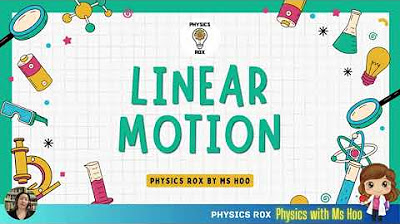kinematics - the basics.
Summary
TLDRIn this educational video, the concept of kinematics is explored, focusing on the distinction between displacement and distance. Displacement, a vector quantity with both magnitude and direction, is the shortest path between two points, while distance is the total path traveled, a scalar quantity. The video clarifies that velocity, calculated as the rate of change of displacement, differs from speed, which is based on distance. Acceleration, another vector quantity, is the rate of change of velocity. The script suggests that graphical analysis, such as displacement versus time graphs, can reveal the interrelationships between these variables, setting the stage for further exploration in subsequent videos.
Takeaways
- 📏 Displacement and distance are not the same; displacement is the shortest path between two points, while distance is the actual path traveled.
- 🔍 Displacement is a vector quantity, meaning it has both magnitude and direction, unlike distance, which is a scalar.
- 🕒 Time is a critical factor in kinematics, as it is used to calculate velocity, which is the rate of change of displacement over time.
- 🏃♂️ Velocity is the change in displacement over time, and it is a vector quantity, indicating it has direction.
- 🚶♀️ Speed is different from velocity; it is the change in distance over time and is a scalar quantity, lacking direction.
- 🔄 Acceleration is the rate of change of velocity over time, and it is also a vector, reflecting changes in both magnitude and direction of velocity.
- 📉 Graphs are used to analyze motion, with common types including displacement vs. time, velocity vs. time, and acceleration vs. time graphs.
- 🔍 These graphs help to visualize and understand the relationships and equations of motion involving displacement, velocity, and acceleration.
- 📚 The video script is from a series on physics, focusing on kinematics, which is the study of motion without considering the forces that cause it.
- 👨🏫 The presenter, Paul, from 'High School Physics Plained', aims to make complex physics concepts accessible and understandable.
Q & A
What is the main focus of the video?
-The main focus of the video is to explain the concept of kinematics, specifically the difference between displacement and distance, and the relationship between velocity, speed, and acceleration.
What is displacement and how is it different from distance?
-Displacement is the straight-line path between two points, representing the shortest path between them, and it includes both magnitude and direction, making it a vector quantity. Distance, on the other hand, is the actual path traveled, which can be any route and is a scalar quantity, having only magnitude without direction.
Why is displacement considered more important than distance in physics?
-Displacement is considered more important in physics because it includes direction, which is critical for understanding motion. It reflects the change in position from the starting point to the ending point, which is essential for analyzing motion in a straight line.
What is the symbol used to represent displacement in physics?
-The symbol used to represent displacement in physics is 's'.
How is velocity defined and what is its relationship with displacement?
-Velocity is defined as the rate of change of displacement, symbolized as 'v'. It is the change in displacement (Δs) over time (Δt), and since displacement is a vector, velocity is also a vector quantity, indicating both speed and direction.
What is the difference between velocity and speed?
-Velocity is a vector quantity based on displacement, which means it includes both magnitude and direction. Speed, however, is a scalar quantity based on distance, representing only the magnitude of how fast an object is moving without considering direction.
What does acceleration measure and how is it different from velocity?
-Acceleration measures how quickly the velocity of an object changes. It is a vector quantity because it is based on velocity, which includes both changes in magnitude and direction. Unlike velocity, which is the rate of change of displacement, acceleration is the rate of change of velocity.
What symbols are commonly used to represent initial and final velocities in equations?
-The symbols 'u' and 'v' are commonly used to represent initial and final velocities, respectively, in equations related to motion and acceleration.
What are the classic graphs used to analyze motion in kinematics?
-The classic graphs used to analyze motion in kinematics include displacement versus time graphs, velocity versus time graphs, and acceleration versus time graphs. These graphs help to visualize and understand the relationships between different variables of motion.
What is the next step in studying kinematics after understanding the basics?
-After understanding the basics of kinematics, the next step is to perform data analysis and graph the data to study the interrelationships between variables such as displacement, velocity, and acceleration. This is often done using the classic graphs mentioned in the video.
Who is the presenter of the video and what is the title of the series?
-The presenter of the video is Paul, and the title of the series is 'High School Physics Plained'.
Outlines

This section is available to paid users only. Please upgrade to access this part.
Upgrade NowMindmap

This section is available to paid users only. Please upgrade to access this part.
Upgrade NowKeywords

This section is available to paid users only. Please upgrade to access this part.
Upgrade NowHighlights

This section is available to paid users only. Please upgrade to access this part.
Upgrade NowTranscripts

This section is available to paid users only. Please upgrade to access this part.
Upgrade NowBrowse More Related Video

Linear Motion - Distance, Displacement, Speed, Velocity, Acceleration - SPM & IGSCE Physics

Posisi, Jarak, Perpindahan, dan Kecepatan | Kinematika 1D | Part 1 | Fisika Dasar

Introduction to Displacement and the Difference between Displacement and Distance

Kinematics in 1 dimension part 1

Conceitos Iniciais de CINEMÁTICA - [Cinemática do Zero 01]

MATERI KINEMATIK kelas 11 bag 1 PENGERTIAN GERAK, JARAK & PERPINDAHAN K Merdeka
5.0 / 5 (0 votes)